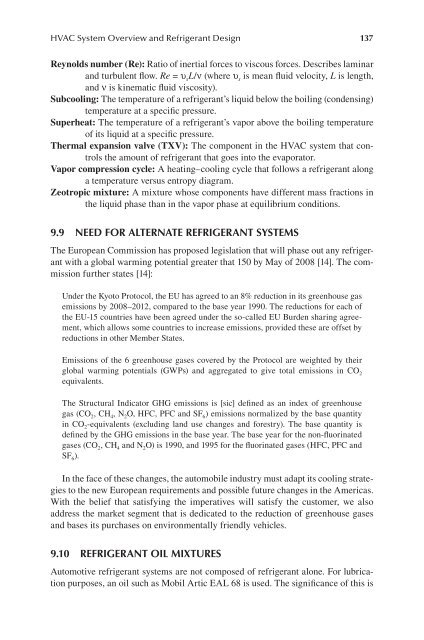THE ROLE OF THE
THE ROLE OF THE
THE ROLE OF THE
Create successful ePaper yourself
Turn your PDF publications into a flip-book with our unique Google optimized e-Paper software.
HVAC System Overview and Refrigerant Design 137<br />
Reynolds number (Re): Ratio of inertial forces to viscous forces. Describes laminar<br />
and turbulent flow. Re = υ sL/ν (where υ s is mean fluid velocity, L is length,<br />
and ν is kinematic fluid viscosity).<br />
Subcooling: The temperature of a refrigerant’s liquid below the boiling (condensing)<br />
temperature at a specific pressure.<br />
Superheat: The temperature of a refrigerant’s vapor above the boiling temperature<br />
of its liquid at a specific pressure.<br />
Thermal expansion valve (TXV): The component in the HVAC system that controls<br />
the amount of refrigerant that goes into the evaporator.<br />
Vapor compression cycle: A heating–cooling cycle that follows a refrigerant along<br />
a temperature versus entropy diagram.<br />
Zeotropic mixture: A mixture whose components have different mass fractions in<br />
the liquid phase than in the vapor phase at equilibrium conditions.<br />
9.9 need For alternate reFrIgerant systems<br />
The European Commission has proposed legislation that will phase out any refrigerant<br />
with a global warming potential greater that 150 by May of 2008 [14]. The commission<br />
further states [14]:<br />
Under the Kyoto Protocol, the EU has agreed to an 8% reduction in its greenhouse gas<br />
emissions by 2008–2012, compared to the base year 1990. The reductions for each of<br />
the EU-15 countries have been agreed under the so-called EU Burden sharing agreement,<br />
which allows some countries to increase emissions, provided these are offset by<br />
reductions in other Member States.<br />
Emissions of the 6 greenhouse gases covered by the Protocol are weighted by their<br />
global warming potentials (GWPs) and aggregated to give total emissions in CO 2<br />
equivalents.<br />
The Structural Indicator GHG emissions is [sic] defined as an index of greenhouse<br />
gas (CO 2, CH 4, N 2O, HFC, PFC and SF 6) emissions normalized by the base quantity<br />
in CO 2-equivalents (excluding land use changes and forestry). The base quantity is<br />
defined by the GHG emissions in the base year. The base year for the non-fluorinated<br />
gases (CO 2, CH 4 and N 2O) is 1990, and 1995 for the fluorinated gases (HFC, PFC and<br />
SF 6).<br />
In the face of these changes, the automobile industry must adapt its cooling strategies<br />
to the new European requirements and possible future changes in the Americas.<br />
With the belief that satisfying the imperatives will satisfy the customer, we also<br />
address the market segment that is dedicated to the reduction of greenhouse gases<br />
and bases its purchases on environmentally friendly vehicles.<br />
9.10 reFrIgerant oIl mIXtures<br />
Automotive refrigerant systems are not composed of refrigerant alone. For lubrication<br />
purposes, an oil such as Mobil Artic EAL 68 is used. The significance of this is







